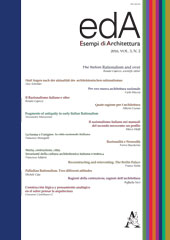Estratto da
ESEMPI DI ARCHITETTURA
International Journal of Architecture and Engineering
Razionalità e neorealtà. Rationality and neo-reality
ESEMPI DI ARCHITETTURA
International Journal of Architecture and Engineering
Razionalità e neorealtà. Rationality and neo-reality

The twentieth century desecrates history, changes boundaries, cancels social identity characteristics,distorts the individual to recreate his genetic code. Architecture has the same fate: the architects of thelast century mean to rewrite the history of architecture through new rules, they encode and list themin prescriptive and essential points that can be applied everywhere. Not all the actors of the architecturaltwentieth century are slaves of this attitude: Giuseppe Pagano, as Bruno Zevi said, searches inthe minor building heritage, almost completely excluded from art history and suggests again an interpretationof minor building for the modern project.The strength of Pagano did not have an immediate grip on the culture of that time, the students immediatelyafter his generation were the ones to recall that attitude of critical interpretation of minorarchitecture; Albini, De Carlo, Gardella but also Muratori, Ridolfi, Michelucci perceived the fragilitywith which the language of the modern movement had faced the issue of the specific social context.Pagano's lesson strongly makes a comeback,seem to come back to the mind of the most sensitive architectsof the postwar period.Sensitivity is precisely the term which is in contrast with indifference; literature, then films, but alsoarchitecture and painting express a critical scenario of the social and economic condition, whosemovement, the neorealism, represents the most interesting cultural phenomenon of the italian postwarperiod..
| pagine: | 49-54 |
| DOI: | 10.4399/97888548991868 |
| data pubblicazione: | Dicembre 2016 |
| editore: | Aracne |








